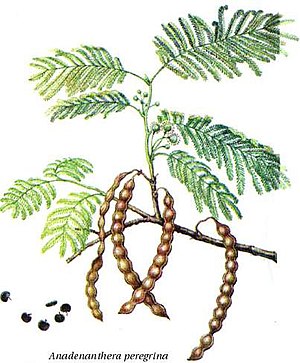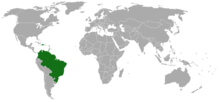Anadenanthera peregrina
| Anadenanthera peregrina | ||||||||||||
|---|---|---|---|---|---|---|---|---|---|---|---|---|

Anadenanthera peregrina |
||||||||||||
| Systematics | ||||||||||||
|
||||||||||||
| Scientific name | ||||||||||||
| Anadenanthera peregrina | ||||||||||||
| ( L. ) Speg. |
Anadenanthera peregrina is one of two plant species from the genus Anadenanthera within the legume family (Fabaceae). Anadenanthera peregrina and Anadenanthera colubrina are common in South America , where they arecalled Yopo and used as a psychoactive drug .
description
Vegetative characteristics
Anadenanthera peregrina grows as a mimosa-like tree or shrub and reaches heights of 4 to 25 m or more with a trunk thickness of 20–40 cm. The brown, sometimes corky bark shows at the bottom of the trunk, heaped on young specimens, greyish and conical, sometimes pointed outgrowths ( armor ).
The approximately 12 to 30 cm long leaves are double-pinnate and are composed of ten to thirty opposite primary pairs of pinnacles. The very many, small and elongated, slightly ciliate and (almost) sedentary leaflets are 2–8 mm long and 0.5–1.5 mm wide, as well as minimally pointed. There may be glands on the petiole.
Generative characteristics
The 35 to 50 very small, almost sessile, five-fold flowers with a double inflorescence are in terminal or axillary, racemose inflorescences in spherical, stalked heads - with a diameter of 10 to 18 mm - together. There are two small, overgrown bracts on the peduncle, a little below the flower base . Each flower has a small wrapper . The hairy, bell-shaped calyx has small, free tips. The five petals are whitish to orange and half fused, with elongated and free tips. The 10 long and protruding stamens with white, thin stamens are between 5 and 8 mm long. The elongated, single-chambered ovary is above and has a short stalk with a long stylus with a small, cephalic scar .
The rough, bald and woody, tipped legume with thickened edges is 5 to 35 cm long and 1 to 3 cm wide. It contains 3 to 15 flat, round, disc-shaped seeds and is constricted between the seeds. These are dark brown to blackish, slightly shiny and have a diameter of 10 to 20 mm.
Occurrence
Anadenanthera peregrina occurs in South America, especially in Brazil , Colombia , Venezuela and Guyana ; it has meanwhile become naturalized in the West Indies and in Haiti the plant is cultivated in plantations. Anadenanthera peregrina prefers sandstone soils and semi-arid locations and is mainly found in plains and grassy regions that are not forested, such as in savannas along watercourses or in open grasslands, and in locations of sea level up to a maximum of 1200 m.
Taxonomy
The first description of Basionyms Mimosa peregrina done in 1753 by Carl Linnaeus in Sp. Pl .: 520. The new combination to Anadenanthera peregrina was made in 1923 by Carlos Luis Spegazzini in physique. (Buenos Aires) 6: 314.
Synonyms for Anadenanthera peregrina Speg. are: Acacia angustiloba DC. , Acacia microphylla Willd. , Acacia peregrina ( L. ) Willd. , Inga niopo Willd. , Mimosa acacioides Benth. , Mimosa niopo (Willd.) Poiret , Mimosa parvifolia Poiret , Niopa peregrina (L.) Britton & Rose , Piptadenia niopo (Willd.) Spruce , Piptadenia peregrina (L.) Benth.
use
Active ingredients
The seeds and bark of Anadenanthera peregrina in particular contain psychoactive substances. They are rich in tryptamine derivatives that are effective as serotonin mimetics , such as N , N -dimethyltryptamine ( N , N -DMT), N , N -dimethyl-5-methoxytryptamine ( 5-MeO-DMT ) and bufotenin (5-hydroxy-dimethyltryptamine) . The plant also contains traces of β-carboline alkaloids, 2-methyltetrahydro-β-carboline is an example. The total alkaloid content of the bark is 0.4%, the content of the seeds 0.2% and the roots contain up to 0.7% alkaloids.
use
The Indians, who live in the northern part of the Amazon Basin , the Orinoco Basin and northern Argentina, have been using yopo powder as a psychedelic for thousands of years . The seeds, first moistened and kneaded into a dough, are roasted and ground into a powder; by mixing with alkaline ash or lime, the Indians obtain the free bases of the alkaloids . The mixture known as Yopo , Niopo , Parica , Cébil , Vilca or Huilca acts as a short-term and strong hallucinogen and is mainly applied nasally (cold), but also rectally as an enema or dermal. The free bases are quickly absorbed and overcome - with the exception of bufotenin - the blood-brain barrier . Nasal, dermal or rectal, the drug is much more effective than orally. Sometimes yopo is smoked with tobacco or eaten mixed with honey.
Symptoms
Depending on the type of application and composition of the drug, symptoms appear after one minute (smoking 5 to 10 mg 5-methoxydimethyltryptamine), two to three minutes (iv administration of 0.7 mg / kg dimethyltryptamine) or 10 to 15 minutes (sniffing of Yopo powder). These include complete loss of identity and multidimensional visions, combined with strong and diverse psychedelic hallucinations. This includes, for example, the transformation into animals, erotic ecstasy and the feeling of flying. The effects are often preceded by headaches, drooling, and vomiting before reaching a trance state with dancing, singing, and screaming.
pharmacology
Anadenanthera peregrina is a strongly hallucinogenic plant with psychoactive properties, which is classified as toxic (II). Bufotenin, N, N-DMT and 5-MeO-DMT activate the serotonin receptors . β-Carboline alkaloids act as strong inhibitors of monoamine oxidase and serotonin antagonists. This explains the hallucinogenic effects. 50 to 80 mg N, N-DMT (intramuscular injection) or 6 to 8 mg bufotenin (intravenous application) are sufficient to induce a strong intoxication.
toxicology
The following LD 50 values were determined in mice after intraperitoneal administration : dimethyltryptamine 110 mg / kg, bufotenine 290 mg / kg and 5-methoxydimethyltryptamine 115 mg / kg.
additional
The beautiful and hard, heavy wood is also known as Patagonian Rosewood , like the similar one from Anadenanthera colubrina .
Legal position
Anadenanthera peregrina is not listed in the annexes of the BtMG . Similar to cacti containing mescaline , possession and trade are permitted, provided that botanical purposes are pursued. Trade and possession of prepared plant parts for use as a drug are prohibited due to the DMT and 5-MeO-DMT they contain .
literature
- Wink, Michael, Ben-Erik van Wyk, Coralie Wink: Handbook of poisonous and psychoactive plants. Wissenschaftliche Verlagsgesellschaft, Stuttgart 2008, ISBN 3-8047-2425-6 .
- Siri von Reis Altschul: A Taxonomic Study of the Genus Anadenanthera. In: Contributions from the Gray Herbarium of Harvard University. No. 193 (1964), pp. 3-65, JSTOR 41764816 .
Web links
- Anadenanthera peregrina at Useful Tropical Plants.
- Yopo . In: Erowid . (English)
Individual evidence
- ↑ a b c d e f g h W. Blaschek, R. Hänsel, K. Keller, J. Reich Ling, H. Rimpler, G. Schneider (ed.): Hager's Handbuch der Pharmazeutischen Praxis, 2 sequence band drug A-K . 5th edition. Springer, Berlin / Heidelberg / New York 2012, ISBN 978-3-642-63794-0 , pp. 81–85 ( online - unaltered reprint of the first edition from 1998).
- ↑ a b Anadenanthera peregrina (L.) Spegazzini. , Mansfeld's World Database of Agriculture and Horticultural Crops, accessed May 16, 2015.
- ↑ a b entry on N, N-dimethyltryptamine. In: Römpp Online . Georg Thieme Verlag, accessed on May 14, 2015.
- ↑ a b Anadenanthera peregrina (L.) SPEG. - Fabaceae. ( Memento from February 19, 2013 in the Internet Archive ) in Dr. Duke's Phytochemical and Ethnobotanical Databases , accessed May 14, 2015.
- ^ A b Marcel Granier-Doyeux: Native hallucinogenic drugs piptadenias. UNODC , Jan 1, 1965, pp. 29-38.
- ↑ ML Pochettino, AR Cortella and M. Ruiz: Hallucinogenic Snuff from Northwestern Argentina: Microscopical Identification of Anadenanthera colubrina var. Cebil (Fabaceae) in Powdered Archaeological Material . In: Economic Botany . tape 53 , no. 2 , 1999, p. 127-132 , JSTOR : 4256172 (English).




